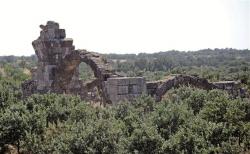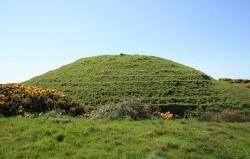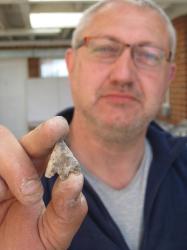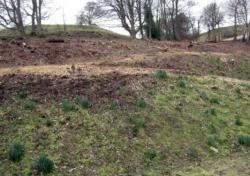INSTITUT SUPERIEUR D'ANTHROPOLOGIE
INSTITUTE OF ANTHROPOLOGY
ONLINE COURSES / COURS A DISTANCE
SUMMER TERM : JULY 2014
REGISTER NOW
ITALIE –  Florence - Archaeologists digging up the remains of an ancient Roman theatre discovered under the Palazzo Vecchio in Florence have found a "vomitorium" or corridor used by as many as 15,000 theatre goers in the first and second centuries A.D., city officials say.The latest find at the site in the centre of the Tuscan capital includes the original painted stone pavements along which spectators used to walk from the outer circle of the theatre to the orchestra pit, which already had been excavated during previous digs. Also discovered were well shafts going as deep as more than 10 metres below the current surface of Florence, providing water and waste disposal for the theatre, as well as remains of the foundations of the walls used to build the Salone dei Cinquecento.The Roman theatre was built originally for use by an audience of some 7,000 people but at the height of its popularity in the first and second centuries AD as many as 10,000-15,000 spectators are believed to have packed in to enjoy performances there, the archaeologists say.The remains of the theatre cover a vast portion of land under Palazzo Vecchio and Palazzo Gondi, with the cavea cells in which wild animals were confined facing the Piazza della Signoria and the 'scena' or stage along what is now the via dei Leoni.The theatre was in use until the 5th century before being abandoned and eventually forgotten. Its remains were gradually brought to light in the 18th century when Florence was transformed into the first capital of a united Italy in 1865 and the city centre was systematically modernised.A new archeological investigation was carried out at the end of the 1990's with full-scale excavations taking place between 2004 and 2010
Florence - Archaeologists digging up the remains of an ancient Roman theatre discovered under the Palazzo Vecchio in Florence have found a "vomitorium" or corridor used by as many as 15,000 theatre goers in the first and second centuries A.D., city officials say.The latest find at the site in the centre of the Tuscan capital includes the original painted stone pavements along which spectators used to walk from the outer circle of the theatre to the orchestra pit, which already had been excavated during previous digs. Also discovered were well shafts going as deep as more than 10 metres below the current surface of Florence, providing water and waste disposal for the theatre, as well as remains of the foundations of the walls used to build the Salone dei Cinquecento.The Roman theatre was built originally for use by an audience of some 7,000 people but at the height of its popularity in the first and second centuries AD as many as 10,000-15,000 spectators are believed to have packed in to enjoy performances there, the archaeologists say.The remains of the theatre cover a vast portion of land under Palazzo Vecchio and Palazzo Gondi, with the cavea cells in which wild animals were confined facing the Piazza della Signoria and the 'scena' or stage along what is now the via dei Leoni.The theatre was in use until the 5th century before being abandoned and eventually forgotten. Its remains were gradually brought to light in the 18th century when Florence was transformed into the first capital of a united Italy in 1865 and the city centre was systematically modernised.A new archeological investigation was carried out at the end of the 1990's with full-scale excavations taking place between 2004 and 2010
http://www.ansa.it/english/news/lifestyle/arts/2014/04/14/roman-theatre-discovery-in-florence_1c9bd451-0c4a-44c7-9bbb-7ac53f8e38da.html
TURQUIE –  Alexandria Troas - An ancient bath, which was constructed nearly 1,880 years ago in the eastern province of Çanakkale’s ancient city of Alexandria Troas in Ezine district’s Dalyan village, is one of the largest known structures and the largest bath in Anatolia from its era. According to the head of the excavation team and Ankara University Archaeology Department member Associate Professor Erhan Öztepe, the Herodes Atticus Bath dates back to 135. Built by the Roman emperor Hadrian’s close friend Athenian Herodes Atticus, the bath is 100 meter long, said Öztepe and added, “The number of bathes in Anatolia in this size is too few. The Herodes Atticus Bath is the largest one in Anatolia in this era.” Öztepe said that this significant structure in the ancient city largely collapsed in an earthquake in the winter of 1809-1810, and they were cleaning the area this year. He said they were working to shed light on some facts in the plan of the structure, and would make it clear by emptying the bath through drilling. He said such a large bath showed the significance of the city at the time. “Just like today, investments like this needed high costs in the ancient era, too. As far as we know from the sources, the structure cost some 3 million drachma [Greek currency at the time]. That was a lot of value in that era. The people of Alexandria Troas received great support from Emperor Hadrian in the establishment of some structures. “According to an inscription in Athens, Hadrian was launched the ‘sponsor of the city’ in 132. An honorary inscription was made for him and placed in Athena Agora, because the emperor had special interest in this city. Three inscriptions that were unearthed in 2006 show Hadrian’s interest in the city and the importance that city gave to him.” The Herodes Atticus Bath, which has similar characteristics with theater bathes in the ancient city of Ephesus and the eastern bathes, is surrounded with walking corridors on three sides. The bath and gymnasium (mental and physical education places in the ancient era) have marble walls and vaults. Water is delivered to the structure through aqueducts northeast of the bath. It is reported that the functions of spaces in the bath and gymnasium have not been clearly determined because there have been no excavations in the area so far. The structure totals 123 x 84 meters and is the largest bath in Anatolia.
Alexandria Troas - An ancient bath, which was constructed nearly 1,880 years ago in the eastern province of Çanakkale’s ancient city of Alexandria Troas in Ezine district’s Dalyan village, is one of the largest known structures and the largest bath in Anatolia from its era. According to the head of the excavation team and Ankara University Archaeology Department member Associate Professor Erhan Öztepe, the Herodes Atticus Bath dates back to 135. Built by the Roman emperor Hadrian’s close friend Athenian Herodes Atticus, the bath is 100 meter long, said Öztepe and added, “The number of bathes in Anatolia in this size is too few. The Herodes Atticus Bath is the largest one in Anatolia in this era.” Öztepe said that this significant structure in the ancient city largely collapsed in an earthquake in the winter of 1809-1810, and they were cleaning the area this year. He said they were working to shed light on some facts in the plan of the structure, and would make it clear by emptying the bath through drilling. He said such a large bath showed the significance of the city at the time. “Just like today, investments like this needed high costs in the ancient era, too. As far as we know from the sources, the structure cost some 3 million drachma [Greek currency at the time]. That was a lot of value in that era. The people of Alexandria Troas received great support from Emperor Hadrian in the establishment of some structures. “According to an inscription in Athens, Hadrian was launched the ‘sponsor of the city’ in 132. An honorary inscription was made for him and placed in Athena Agora, because the emperor had special interest in this city. Three inscriptions that were unearthed in 2006 show Hadrian’s interest in the city and the importance that city gave to him.” The Herodes Atticus Bath, which has similar characteristics with theater bathes in the ancient city of Ephesus and the eastern bathes, is surrounded with walking corridors on three sides. The bath and gymnasium (mental and physical education places in the ancient era) have marble walls and vaults. Water is delivered to the structure through aqueducts northeast of the bath. It is reported that the functions of spaces in the bath and gymnasium have not been clearly determined because there have been no excavations in the area so far. The structure totals 123 x 84 meters and is the largest bath in Anatolia.
http://www.hurriyetdailynews.com/largest-bath-in-roman-era-a-costly-investment-of-time.aspx?pageID=238&nid=65026&NewsCatID=375
Irlande –  Ballygarrett -A call has gone out for an archaeological study to be carried out on an ancient Norman monument in Ballygarrett, which is about to be lost to the sea.The Glasscarraig Motte, where a Wooden Castle dating back to the late 1100s once stood, stands on the edge of a crumbling sea cliff at Glasscarraig Bay near Ballygarrett.Part of an adjoining Bailey, an enclosed courtyard, has already disappeared into the sea. 'The Motte and Bailey site was of incredible importance,' said archaeologist Byron Jones. 'It was one of the very first fortifications built by the Normans in Ireland. The site formed part of an invaluable defensive chain along the East Wexford coastline protecting vital economic Norman interests along it.' Byron explained that it was built sometime in the late 1170s or the 1180s under the supervision of Raymond Le Gros who was the leader of the second Norman Invasion of Ireland which landed in Baginbun, South Wexford in 1170.
Ballygarrett -A call has gone out for an archaeological study to be carried out on an ancient Norman monument in Ballygarrett, which is about to be lost to the sea.The Glasscarraig Motte, where a Wooden Castle dating back to the late 1100s once stood, stands on the edge of a crumbling sea cliff at Glasscarraig Bay near Ballygarrett.Part of an adjoining Bailey, an enclosed courtyard, has already disappeared into the sea. 'The Motte and Bailey site was of incredible importance,' said archaeologist Byron Jones. 'It was one of the very first fortifications built by the Normans in Ireland. The site formed part of an invaluable defensive chain along the East Wexford coastline protecting vital economic Norman interests along it.' Byron explained that it was built sometime in the late 1170s or the 1180s under the supervision of Raymond Le Gros who was the leader of the second Norman Invasion of Ireland which landed in Baginbun, South Wexford in 1170.
http://www.independent.ie/regionals/goreyguardian/news/norman-site-may-soon-be-lost-to-sea-30165040.html
CHINE - Nanchangtan - Archaeologists have discovered sections of the Great Wall in a valley of northwest China's Ningxia Hui Autonomous Region, a former museum curator said on Tuesday. The 20-meter long wall was found in a valley of Nanchangtan Village, Zhongwei City. It is believed to be part of the Great Wall built during the Qin Dynasty (221 BC-206 BC), said Zhou Xinghua, former curator of the Museum of Ningxia Hui Autonomous Region. It consists of three sections, with one section constructed with stones. It is five meters long, three to four meters wide and six meters tall. The other two sections are 10 meters and five meters long respectively. Zhou said to prevent foreign invaders from crossing the Yellow River when it was frozen, the Qin state, which defeated other powers during the Warring States Period (475-221 BC) and later established the Qin Dynasty, built great walls along the valley beside the Yellow River. According to historical records, the newly found wall remains are believed to have a history of over 2,470 years. "It proves that the Great Wall was built in the valley with mountain stones, and needs better protection owing to its great historical value," Zhou said.
http://www.shanghaidaily.com/article/article_xinhua.aspx?id=212795
ROYAUME UNI –  Salisbury - Nice objects aren’t just found in the field – from time to time something special pops up back in the laboratory too. This fine Early Bronze Age barbed and tanged flint arrowhead was recovered from a palaeoenvironmental sample taken from an interesting pit on a site near Salisbury earlier this year. The pit was Iron Age, and also contained Iron Age pottery, smashed quernstones, animal bone, and an inhumation burial. However, as well as the early arrowhead, it also contained well preserved Beaker pottery. These Early Bronze Age artefacts are likely to have been found locally and included deliberately in the pit, possibly to accompany the Iron Age burial.
Salisbury - Nice objects aren’t just found in the field – from time to time something special pops up back in the laboratory too. This fine Early Bronze Age barbed and tanged flint arrowhead was recovered from a palaeoenvironmental sample taken from an interesting pit on a site near Salisbury earlier this year. The pit was Iron Age, and also contained Iron Age pottery, smashed quernstones, animal bone, and an inhumation burial. However, as well as the early arrowhead, it also contained well preserved Beaker pottery. These Early Bronze Age artefacts are likely to have been found locally and included deliberately in the pit, possibly to accompany the Iron Age burial.
http://www.wessexarch.co.uk/blogs/news/2014/04/15/sample-jackpot?utm_source=feedburner&utm_medium=feed&utm_campaign=Feed%3A+wessexarchaeology+%28Wessex+Archaeology%29
ROYAUME UNI –  Loanhead - You often find a few unexpected things while tidying up your garden, but how about paths leading to a Roman fort? Staff cutting back shrubs in the grounds of Mavisbank House, just outside Loanhead, have just revealed the ancient roads after a mass of rhododendron was removed. Work is now under way by Historic Scotland to examine the find further to map out the former life of the site at the rear of the 18th century property. Historic Scotland believes they could lead to an Iron Age earthwork which is thought to be a Roman fort and part of the reason why the second Baronet of Penicuik, Sir John Clerk, chose the site for his home when it was built between 1723 and 1727.
Loanhead - You often find a few unexpected things while tidying up your garden, but how about paths leading to a Roman fort? Staff cutting back shrubs in the grounds of Mavisbank House, just outside Loanhead, have just revealed the ancient roads after a mass of rhododendron was removed. Work is now under way by Historic Scotland to examine the find further to map out the former life of the site at the rear of the 18th century property. Historic Scotland believes they could lead to an Iron Age earthwork which is thought to be a Roman fort and part of the reason why the second Baronet of Penicuik, Sir John Clerk, chose the site for his home when it was built between 1723 and 1727.
http://www.edinburghnews.scotsman.com/news/removal-of-shrubs-reveals-ancient-roman-fort-paths-1-3376650
BULGARIE -  Bulgarian police have handed the remnants of three ancient necklaces to the country's most important museum after seizing the artifacts from smugglers who looted them from archaeological sites.Police gave the artifacts to the National Museum of History in Sofia, whose collection is among the largest in the Balkans.The museum's director, Bozhidar Dimitrov, says the broken jewelry pieces are among the oldest such items ever discovered in Bulgaria. The pieces date to the third millennium B.C.
Bulgarian police have handed the remnants of three ancient necklaces to the country's most important museum after seizing the artifacts from smugglers who looted them from archaeological sites.Police gave the artifacts to the National Museum of History in Sofia, whose collection is among the largest in the Balkans.The museum's director, Bozhidar Dimitrov, says the broken jewelry pieces are among the oldest such items ever discovered in Bulgaria. The pieces date to the third millennium B.C.
http://ap.org/